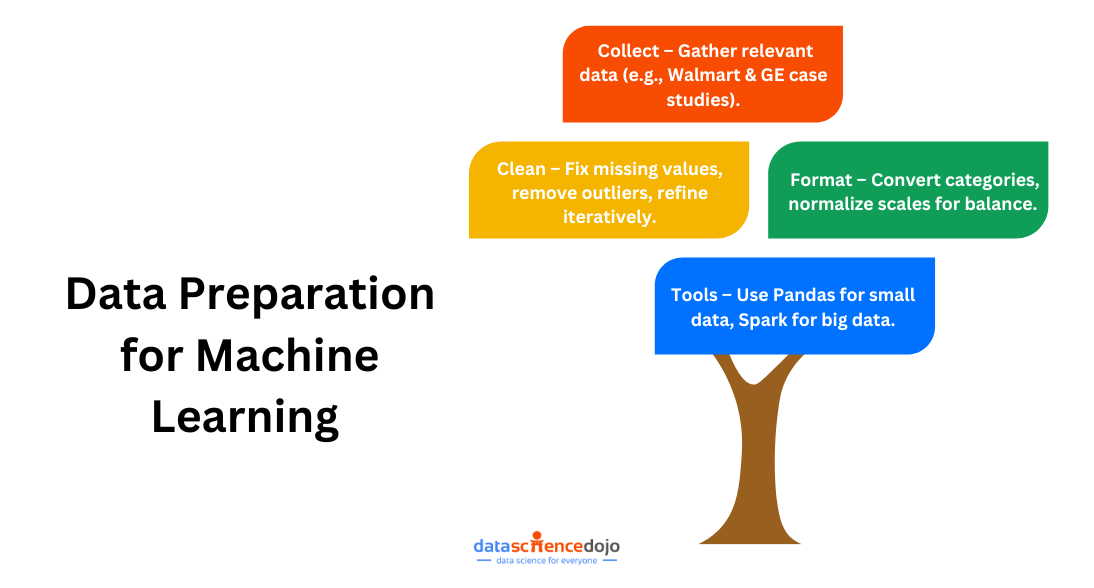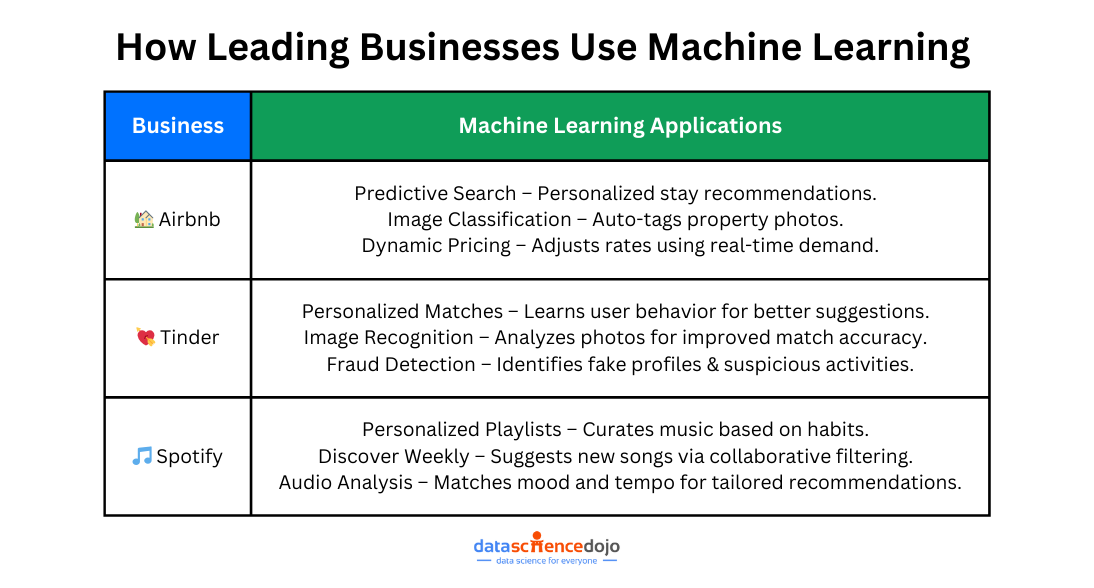Imagine a world where your business could make smarter decisions, predict customer behavior with astonishing accuracy, and automate tasks that used to take hours. That world is within reach through machine learning (ML).
In this machine learning guide, we’ll take you through the end-to-end ML process in business, offering examples and insights to help you understand and harness its transformative power. Whether you’re just starting with ML or want to dive deeper, this guide will equip you with the knowledge to succeed.

Interested in learning machine learning? Learn about the machine learning roadmap
Machine Learning Guide: End-to-End Process
Let’s simplify the machine learning process into clear, actionable steps. No jargon—just what you need to know to build, deploy, and maintain models that work.
1.Nail Down the Problem
When it comes to machine learning, success starts long before you write a single line of code—it begins with defining the problem clearly.
Begin by asking yourself: “What is the specific problem I’m solving?” This might sound obvious, but the clarity of your initial problem statement can make or break your project. Instead of a vague goal like “improve sales,” refine your objective to something actionable and measurable. For example:
- Clear Objective: “Predict which customers will buy Product X in the next month using their browsing history.”
This level of specificity helps ensure that your efforts are laser-focused and aligned with your business needs.
Real-World Examples
To see this in action, consider how industry leaders have tackled their challenges:
-
Netflix: Their challenge wasn’t just about keeping users entertained—it was about engaging them through personalized recommendation engines. Netflix’s ML models analyze viewing habits to suggest content that keeps users coming back for more.
-
PayPal: For PayPal, the problem was ensuring security without compromising user experience. They developed real-time transaction analysis systems that detect and prevent fraud almost instantaneously, all while minimizing inconvenience for genuine users.
Both examples underscore the importance of pinpointing the problem. A well-defined challenge paves the way for a tailored Machine Learning solution that directly addresses key business objectives.
Pro Tips for Getting Started
-
Test If ML Is Necessary: Sometimes, traditional analytics like trend reports or descriptive statistics might solve the problem just as well. Evaluate whether the complexity of Machine learning is warranted before proceeding.
-
Set Success Metrics Early:
- Accuracy: Determine what level of accuracy is acceptable for your application. For instance, is 85% accuracy sufficient, or do you need more precision?
- Speed: Consider the operational requirements. Does the model need to make decisions in milliseconds (such as for fraud detection), or can it operate on a slower timescale (like inventory restocking)?
By asking these questions upfront, you ensure that your project is grounded in realistic expectations and measurable outcomes.
2.Data: Gather, Clean, Repeat
Data is the lifeblood of any machine learning project. No matter how sophisticated your algorithm is, its performance is directly tied to the quality and relevance of the data it learns from. Let’s break down how to gather, clean, and prepare your data for success.

What to Collect
The first step is to identify and collect the right data. Your goal is to pinpoint datasets that directly address your problem.
Here are two industry examples to illustrate this:
-
Walmart’s Stock Optimization:
Walmart integrates multiple data sources—sales records, weather forecasts, and shipping times—to accurately predict stock needs. This multifaceted approach ensures that inventory is managed proactively, reducing both overstock and stockouts. -
GE’s Predictive Maintenance:
GE monitors sensor data from jet engines to predict potential mechanical failures. By collecting real-time operational data, they can flag issues before they escalate into costly failures, ensuring safety and efficiency.
In both cases, the data is specifically chosen because it has a clear, actionable relationship with the business objective. Determine the signals that matter most to your problem, and focus your data collection efforts there.
Cleaning Hacks
Raw data rarely comes perfectly packaged. Here’s how to tackle the common pitfalls:
-
Fix Missing Values:
Data gaps are inevitable. You can fill missing values using simple imputation methods like the mean or median of the column. Alternatively, you might opt for algorithms like XGBoost, which can handle missing data gracefully without prior imputation. -
Eliminate Outliers:
Outliers can distort your model’s understanding of the data. For instance, encountering a record like “10 million purchase” in a dataset of 100 orders likely indicates a typo. Such anomalies should be identified and either corrected or removed to maintain data integrity.
Cleaning your data isn’t a one-time step—it’s an iterative process. As you refine your dataset, continue to clean and adjust until your data is as accurate and consistent as possible.
Formatting for Success
After cleaning, you need to format your data so that machine learning algorithms can make sense of it:
-
Convert Categorical Data:
Many datasets contain categorical variables (e.g., “red,” “blue,” “green”). Algorithms require numerical input, so you’ll need to convert these using techniques like one-hot encoding, which transforms each category into a binary column. -
Normalize Scales:
Features in your data can vary drastically in scale. For example, “income” might range from 0 to 100,000, whereas “age” ranges from 0 to 100. Normalizing these features ensures that no single feature dominates the learning process, leading to fairer and more balanced results.
Proper formatting not only prepares the data for modeling but also enhances the performance and interpretability of your machine learning model.
Toolbox
Choosing the right tools for data manipulation is crucial:
-
Python’s Pandas:
For small to medium-sized datasets, Pandas is an invaluable library. It offers robust data manipulation capabilities, from cleaning and transforming data to performing exploratory analysis with ease. -
Apache Spark:
When dealing with large-scale datasets or requiring distributed computing, Apache Spark becomes indispensable. Its ability to handle big data efficiently makes it ideal for complex data wrangling tasks, ensuring scalability and speed.
Also explore: Top 9 ML algorithms for marketing
3.Pick the Right Model
Choosing the right model is a critical step in your machine learning journey. The model you select should align perfectly with your problem type and the nature of your data. Here’s how to match your problem with the appropriate algorithm and set yourself up for training success.
Match Your Problem to the Algorithm
Supervised Learning (When You Have Labeled Data)
Supervised learning is your go-to when you have clear, labeled examples in your dataset. This approach lets your model learn a mapping from inputs to outputs.
-
Predicting Numbers:
For tasks like estimating house prices or forecasting sales, linear regression is often the best starting point. It’s designed to predict continuous values by finding a relationship between independent variables and a target number. -
Classifying Categories:
When your objective is to sort data into categories (think spam vs. not spam emails), decision trees can be a powerful tool. They split data into branches to help make decisions based on feature values, providing clear, interpretable results.
Unsupervised Learning (When Labels Are Absent)
Sometimes, your data won’t come with labels, and your goal is to uncover hidden structures or patterns. This is where unsupervised learning shines.
- Grouping Users:
To segment customers or users into meaningful clusters, K-means clustering is highly effective. For example, Spotify might use clustering techniques to segment users based on listening habits, enabling personalized playlist recommendations without any pre-defined labels.
Training Secrets
Once you’ve matched your problem with an algorithm, these training tips will help ensure your model performs well:
-
Split Your Data:
Avoid overfitting by dividing your dataset into a training set (about 80%) and a validation set (around 20%). This split lets you train your model on one portion of the data and then validate its performance on unseen data, ensuring it generalizes well. -
Start Simple:
Don’t jump straight into complex models. A basic model, such as logistic regression for classification tasks, can often outperform a more complex neural network if the latter isn’t well-tuned. Begin with simplicity, and only increase complexity as needed based on your model’s performance and the intricacies of your data.
Master the machine learning algorithms in this blog
4.Test, Tweak, Repeat
Testing your machine learning model in a controlled environment is only the beginning. A model that works perfectly in the lab might stumble when faced with real-world data. That’s why a rigorous cycle of testing, tweaking, and repeating is essential to refine your model until it meets your performance benchmarks in practical settings.
Metrics That Matter
Before you dive into adjustments, you need to know how well your model is performing. Here are a few key metrics to track:
-
Accuracy:
This tells you the percentage of correct predictions your model makes. While it’s a useful starting point, accuracy alone can be misleading, especially with imbalanced datasets. -
Precision:
Precision measures the percentage of positive identifications (for example, fraud alerts) that are actually correct. In a fraud detection scenario, high precision means that most flagged transactions are genuinely fraudulent, minimizing false alarms. -
Recall:
Recall is the percentage of total actual positive cases (like actual fraud cases) that your model successfully identifies. A model with high recall catches more instances of fraud, though it may also increase false positives if not balanced properly.
These metrics provide a multi-faceted view of your model’s performance, ensuring you don’t overlook important aspects like the cost of false positives or negatives.
The Fix-It Playbook
Once you’ve established your performance metrics, it’s time to refine your model with some targeted tweaks:
-
Tweak Hyperparameters:
Every algorithm comes with its own set of hyperparameters that control how fast a neural network learns, the depth of decision trees, or the regularization strength in regression models. Experimenting with these settings can significantly improve model performance. For example, adjusting the learning rate in a neural network might prevent it from overshooting the optimal solution. -
Address Imbalanced Data:
Many real-world datasets are imbalanced. In a fraud detection scenario, you might find that 99% of transactions are legitimate while only 1% are fraudulent. This imbalance can cause your model to lean towards predicting the majority class. One effective strategy is to oversample the rare class (fraud cases) or use techniques like Synthetic Minority Over-sampling Technique (SMOTE) to create a more balanced dataset. -
Iterative Testing:
Once you’ve made your adjustments, it’s crucial to revalidate your model. Does it still perform well on your validation set? Are there any new errors or biases that have emerged? Continuous testing and validation help ensure your tweaks lead to real improvements rather than unintended consequences.
Red Flag: Revisit Your Data
If your model fails to meet the expected performance during validation, consider revisiting your data:
-
Hidden Patterns:
It might be that important signals or patterns in your data are being missed. Perhaps there’s a subtle correlation or a feature interaction that wasn’t captured during initial data preparation. Going back to your data, exploring it further, and even gathering more relevant data can sometimes be the missing piece of the puzzle. -
Data Quality Issues:
Re-examine your data cleaning process. Incomplete, noisy, or biased data can lead your model astray. Make sure your data preprocessing steps—like handling missing values and eliminating outliers—are robust enough to support your model’s learning process.
You might also like: ML Demos as a Service
5.Deployment: Launch Smart, Not Fast
When it comes to deploying your machine learning model, remember: Launch Smart, Not Fast. This is where theory meets reality, and even the most promising model must prove its worth under real-world conditions. Before you hit the deploy button, consider the following aspects to ensure a smooth transition from development to production.
Ask the Right Questions
Before deployment, it’s crucial to understand how your model will operate in its new environment:
-
Real-Time vs. Batch Predictions:
Ask yourself, “Will predictions happen in real-time or in batches?” For example, a fraud detection system demands instant, real-time responses, whereas a model generating nightly sales forecasts can work on a batch schedule. The decision here affects both the design and the infrastructure you’ll need. -
Data Ingestion:
Determine how your model will receive new data once it’s deployed. Will it integrate via APIs, or will it rely on direct database feeds? The method of data integration can influence both the model’s performance and its reliability in production.
Tools to Try
Leveraging the right tools can streamline your deployment process and help you scale efficiently:
-
Cloud Platforms:
Consider using cloud services like AWS SageMaker or Google AI Platform. These platforms not only simplify deployment but also offer scalability and management features that ensure your model can handle increasing loads as your user base grows. -
Edge Devices:
If your model needs to run on mobile phones, IoT sensors, or other edge devices, frameworks like TensorFlow Lite are invaluable. They enable you to deploy lightweight models that can operate efficiently on devices with limited computational power, ensuring quick responses and reducing latency.
Give it a read too: ML Techniques
6.Monitor Forever (Yes, Forever)
Once your machine learning model is live, the journey is far from over. The real world is in constant flux, and your model must evolve along with it. Monitoring your model is not a one-time event—it’s a continuous process that ensures your model remains accurate, relevant, and effective as data changes over time.
The Challenge: Model Degradation
No matter how well you build your model, it can degrade as the underlying data evolves. Two key phenomena to watch out for are:
-
Data Drift:
Over time, the statistical properties of your input data can change. For example, customer habits might shift dramatically—think of the surge in online shopping post-pandemic. When your model is trained on outdated data, its predictions may no longer reflect current trends. -
Concept Drift:
This occurs when the relationship between input features and the target output shifts. A classic case is inflation altering spending patterns; even if the data seems consistent, the underlying dynamics can change, causing your model’s accuracy to slip.
Your Survival Kit for Continuous Monitoring
To ensure your model stays on track, it’s crucial to implement a robust monitoring and updating strategy. Here’s how to keep your model in peak condition:
-
Regular Retraining:
Schedule regular intervals for retraining your model—monthly might work for many applications, but industries like finance, where market conditions shift rapidly, may require weekly updates. Regular retraining helps incorporate the latest data and adjust to any emerging trends. -
A/B Testing:
Don’t simply replace your old model with a new one without evidence of improvement. Use A/B testing to compare the performance of the new model against the old version. This approach provides clear insights into whether the new model is genuinely better or if further adjustments are needed. -
Performance Dashboards:
Set up real-time dashboards that track key performance metrics such as accuracy, precision, recall, and other domain-specific measures. These dashboards serve as an early warning system, alerting you when performance starts to degrade. -
Automated Alerts:
Implement automated alerts to notify you when your model’s performance dips below predefined thresholds. Early detection allows you to quickly investigate and address issues before they impact your operations.
Use machine learning to optimize demand planning for your business
Leading Businesses Using Machine Learning Applications

Airbnb:
Airbnb stands out as a prime case study in any machine learning guide, showcasing how advanced algorithms can revolutionize business operations and elevate customer experiences. By integrating cutting-edge ML applications, Airbnb optimizes efficiency while delivering hyper-personalized services for guests and hosts.
Here’s how they leverage machine learning—a blueprint that doubles as a practical machine learning guide for businesses:
Predictive Search
Airbnb’s predictive search is designed to make finding the perfect stay as intuitive as possible. Here’s how it works:
-
Tailored Recommendations:
By analyzing guest preferences—such as past bookings, search history, and favored amenities—along with detailed property features like location, design, and reviews, Airbnb’s system intelligently ranks listings that are most likely to meet a guest’s expectations. -
Enhanced User Experience:
This targeted approach reduces the time users spend sifting through irrelevant options. Instead, they see listings that best match their unique tastes and needs, leading to a smoother booking process and higher conversion rates.
Image Classification
In the hospitality industry, a picture is worth a thousand words. Airbnb leverages image classification to ensure that every listing showcases its most appealing aspects:
-
Automatic Photo Tagging:
Advanced algorithms automatically analyze and categorize property photos. They highlight key features—like breathtaking views, cozy interiors, or modern amenities—making it easier for potential guests to assess a property at a glance. -
Improved Listing Quality:
By consistently presenting high-quality images that accentuate a property’s strengths, Airbnb helps hosts attract more interest and bookings. This automated process not only saves time but also maintains a uniform standard of visual appeal across the platform.
Dynamic Pricing
Pricing can make or break a booking. Airbnb’s dynamic pricing model uses machine learning to help hosts stay competitive while ensuring guests receive fair value:
-
Real-Time Data Analysis:
The system factors in variables such as current demand, seasonal trends, local events, and historical booking data. By doing so, it suggests optimal pricing tailored to each property and market condition. -
Maximized Revenue and Occupancy:
For hosts, this means pricing that adapts to market fluctuations—maximizing occupancy and revenue without the guesswork. For guests, dynamic pricing can translate into competitive rates and more transparent pricing strategies.
Also learn ML using Python in Cloud
Tinder:
Tinder has become a leader in the dating app industry by using machine learning to improve user experience, match accuracy, and protect against fraud. In this machine learning guide, we’ll take a closer look at how Tinder uses machine learning to enhance its platform and make the dating experience smarter and safer.
Personalized Recommendations
Tinder’s recommendation engine uses machine learning to ensure users are presented with matches that fit their preferences and behaviors:
-
Behavioral Analysis:
Tinder analyzes user data such as swiping patterns, liked profiles, and even message interactions to understand a user’s tastes and dating preferences. This data is used to suggest potential matches who share similar interests, hobbies, or other key attributes. -
Dynamic Matching:
The algorithm continuously adapts to evolving user preferences, ensuring that each match suggestion is more accurate over time. This personalization enhances user engagement, as people are more likely to find compatible matches quickly.
Image Recognition
Photos play a critical role in dating app interactions, and Tinder uses image recognition to boost the relevance of its matching system:
-
Automatic Classification:
Tinder uses machine learning algorithms to analyze and classify user-uploaded photos. This helps the app understand visual preferences—such as identifying users’ facial expressions, body language, and context (e.g., group photos or solo shots)—to present images that align with other users’ preferences. -
Enhanced Match Accuracy:
By considering photo content, Tinder enhances the quality of match suggestions, ensuring that visual appeal aligns with the personality and interests of both users. This also improves user confidence in the matching process by providing more relevant, visually engaging profiles.
Fraud Detection
Preventing fraudulent activity is crucial in maintaining trust on a platform like Tinder. Machine learning plays a significant role in detecting fake profiles and scams:
- Profile Verification:
Tinder uses advanced algorithms to analyze profile behavior and detect inconsistencies that might suggest fraudulent activity. This includes analyzing rapid, suspicious activity, such as multiple account creations or unusual swiping patterns that are characteristic of bots or fake accounts. - Fake Image Detection:
Image recognition technology also helps identify potentially fake or misleading profile pictures by cross-referencing images from public databases to detect stolen or artificially altered photos. - Safety for Users:
By continuously monitoring for fraudulent behavior, Tinder ensures a safer environment for users. This not only improves the overall trustworthiness of the platform but also reduces the chances of users falling victim to scams or malicious profiles.
Spotify:
Spotify has revolutionized the way people discover and enjoy music, and much of its success is driven by the power of machine learning. Here’s how Spotify uses machine learning to personalize the music experience for each user. In this machine learning guide, we’ll explore how Spotify uses machine learning to personalize the music experience for each user:
Personalized Playlists
Spotify’s recommendation engine analyzes user listening habits to create highly personalized playlists. This includes:
-
User Behavior Analysis:
The app tracks everything from the songs you skip to the ones you repeat, and even the time of day you listen to music. This data is used to create customized playlists that fit your unique listening preferences, ensuring that every playlist feels tailor-made for you. -
Tailored Artist Suggestions:
Based on listening history, Spotify suggests new songs or artists that align with your taste. For instance, if you regularly listen to indie rock, you might receive new recommendations in that genre, making your music discovery seamless and more enjoyable.
Discover Weekly
Every week, Spotify generates a personalized playlist known as Discover Weekly—a unique collection of songs that users are likely to enjoy but haven’t heard before. Here’s how it works:
-
Collaborative Filtering:
Spotify uses collaborative filtering to recommend songs based on similar listening patterns from other users. The algorithm identifies users with comparable tastes and suggests tracks that they’ve enjoyed, which the system predicts you might also like. -
Constant Learning:
The more you use Spotify, the better the algorithm gets at tailoring your weekly playlist. It learns from your likes, skips, and skips-to-replay patterns to refine the recommendations over time, ensuring that each week’s playlist feels fresh and aligned with your current mood and preferences.
Audio Feature Analysis
In addition to analyzing listening behavior, Spotify also uses machine learning to evaluate the audio features of songs themselves:
-
Analyzing Audio Features:
Spotify’s algorithm looks at musical attributes such as tempo, rhythm, mood, and key to assess similarities between songs. This allows the platform to recommend tracks that sound alike, helping users discover new music that fits their preferred style, whether they want something energetic, relaxing, or melancholic. -
Mood-Based Recommendations:
Spotify’s machine learning models also help match users’ moods with the right music. For example, if you tend to listen to slower, melancholic songs in the evening, the system will recommend similar tracks that align with that mood.(Source)
Conclusion
Machine learning doesn’t have to be intimidating. This guide breaks down the basics into bite-sized pieces that you can build on, whether you’re just starting out or looking to polish your skills. Remember, learning ML is all about experimenting, making mistakes, and gradually improving. Keep exploring, practicing, and most importantly, have fun with it. Thanks for joining us on this journey into the world of machine learning!





